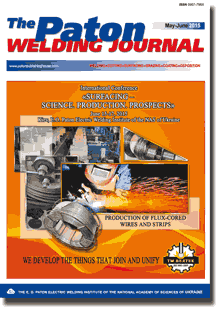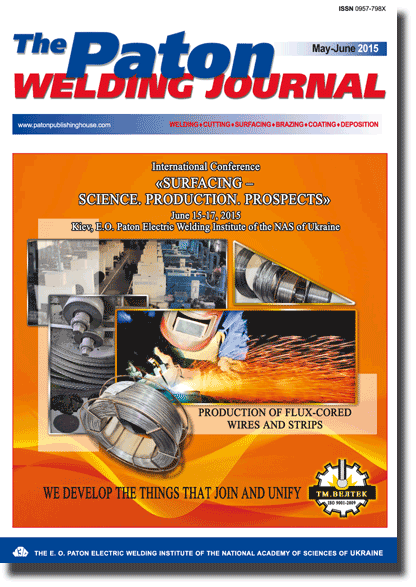| 2015 №06 (21) |
DOI of Article 10.15407/tpwj2015.06.22 |
2015 №06 (23) |

The Paton Welding Journal, 2015, #5-6, 96-100 pages
Structure and properties of railway wheel surface after restoration surfacing and service loading
L.I. Markashova, V.D. Poznyakov, A.A. Gajvoronsky, E.N. Berdnikova And T.A. Alekseenko
E.O. Paton Electric Welding Institute, NASU. 11 Bozhenko Str., 03680, Kiev, Ukraine. E-mail: office@paton.kiev.ua
Abstract
Presented are the investigations of effect of composition of surfacing consumables on structure and phase composition of deposited metal of surfacing zones (surface, fusion line, HAZ) in restoration of railway wheels from grade 2 steel. Information received at different structural layers (from grain to dislocation) was used for analytical estimations of effect of parameters of forming structures on mechanical properties (s0.2, K1c) of railway wheels, reconstructed by surfacing, before and after operation. Role of structural factors in change of level of local internal stresses tl.in, i.e. sources of crack formation in subsurface layers of deposited metal, was investigated. It is determined that surfacing consumables of bainite and bainite-martensite classes provide for high indices of mechanical properties and crack resistance of railway wheels after restoration repair and operation. 9 Ref., 1 Table, 5 Figures.
Keywords: surfacing, railway wheels, deposited metal, heat-affected zone, structure, phase composition, mechanical properties, crack resistance
Received: 01.04.15
Published: 28.07.15
References
1. Pavlov, N.V., Kozubenko, I.D., Byzova, N.E. et al. (1993) Hardfacing of flanges of car wheel pair. Zh.-D. Transport, 7, 37-40.
2. Sarzhevsky, V.A., Gajvoronsky, A.A., Gordonny, V.G. et al. (1996) Influence of technological factors on structure and properties of HAZ metal in repair-restoration hardfacing of flanges of car solid-rolled wheels. Avtomatich. Svarka, 3, 22-27, 33.
3. Gudkov, A.V., Lozinsky, V.N. (2008) New technological and technical solutions in field of railway transport welding. Vestnik VNIIZhT, 6, 3-9.
4. Markashova, L.I., Poznyakov, V.D., Gajvoronsky, A.A. et al. (2011) Evaluation of strength and crack resistance of railway wheel metal after long-term service. Fiz.-Khimichna Mekhanika Materialiv, 6, 73-79.
5. Goldshtejn, M.I., Litvinov, V.S., Bronfin, B.M. (1986) Physics of metals of high-strength alloys. Moscow: Metallurgiya.
6. Romaniv, O.N. (1979) Fracture toughness of structural steels. Moscow: Metallurgiya.
7. Gordienko, L.K. (1973) Ultrafine grain in metals. Moscow: Metallurgiya.
8. Gajvoronsky, A.A., Poznyakov, V.D., Markashova, L.I. et al. (2012) Influence of deposited metal composition on structure and mechanical properties of reconditioned railway wheels. The Paton Welding J., 8, 16-22.
9. Markashova, L.I., Poznyakov, V.D., Berdnikova, E.N. et al. (2014) Effect of structural factors on mechanical properties and crack resistance of welded joints of metals, alloys and composite materials. Ibid., 6/7, 22-28. https://doi.org/10.15407/tpwj2014.06.04
Suggested Citation
L.I. Markashova, V.D. Poznyakov, A.A. Gajvoronsky, E.N. Berdnikova And T.A. Alekseenko (2015) Structure and properties of railway wheel surface after restoration surfacing and service loading. The Paton Welding J., 06, 96-100.The cost of subscription/purchase order journals or individual articles
| Journal/Currency | Annual Set | 1 issue printed |
1 issue |
one article |
| TPWJ/USD | 384 $ | 32 $ | 26 $ | 13 $ |
| TPWJ/EUR | 348 € | 29 € | 24 € | 12 € |
| TPWJ/UAH | 7200 UAH | 600 UAH | 600 UAH | 280 UAH |
| AS/UAH | 1800 UAH | 300 UAH | 300 UAH | 150 UAH |
| AS/USD | 192 $ | 32 $ | 26 $ | 13 $ |
| AS/EUR | 180 € | 30 € | 25 € | 12 € |
| SEM/UAH | 1200 UAH | 300 UAH | 300 UAH | 150 UAH |
| SEM/USD | 128 $ | 32 $ | 26 $ | 13 $ |
| SEM/EUR | 120 € | 30 € | 25 € | 12 € |
| TDNK/UAH | 1200 UAH | 300 UAH | 300 UAH | 150 UAH |
| TDNK/USD | 128 $ | 32 $ | 26 $ | 13 $ |
| TDNK/EUR | 120 € | 30 € | 25 € | 15 € |
AS = «Automatic Welding» - 6 issues per year;
TPWJ = «PATON WELDING JOURNAL» - 12 issues per year;
SEM = «Electrometallurgy Today» - 4 issues per year;
TDNK = «Technical Diagnostics and Non-Destructive Testing» - 4 issues per year.


